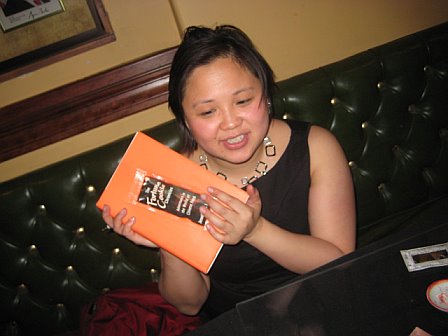Is the Wonton font a racial stereotype?
NOTE to visitors who may have come across this 2009 blog post from a 2019 New York Times article by Nina Ichikawa, "Looking for a Gold-Rush Town Named Chinese Camp," which links to my old blog post because the writer saw the wonton font on a building in northern California, I was surprised to see the bump in traffic from the link. So I updated the piece and re-posted it on my newer Nikkei View blog. Thanks for visiting, and please check out the new site. - Gil Asakawa

Can a font express a racial stereotype?
I know I'm climbing on my soap box and risking being called over-sensitive and too p.c. But when I noticed a promo on Facebook this morning for the Asia Food Fest in Austin, Texas, and saw the logo for the event, my stomach clenched just a little bit. The words were spelled out in the "Wonton" font, the curvy, pointy -- shall I say, "slanty" -- lettering that I associate with a lifetime of Asian racial caricatures.
I hate it when non-Asians use it as a way of appearing "Asian," and I'm disappointed when Asians use it thinking that non-Asians will identify with it. Austin's Asia Food Fest, which I'm sure is a wonderful event, is organized by the Texas Asian Chamber of Commerce, Texas Culinary Academy, and SATAY Restaurant (one of my favorite restaurants anywhere, and one I visited every year for a decade when I attended the South By Southwest music festival), so it's not a phony, faux-Asian affair. Here's how the Fest was started, from its About page:
Dr. Foo Swasdee, owner of SATAY Restaurant, founded the ASIA Food Fest in 2006 to educate people about Asian ingredients, food, and cooking. As Austin Asian population grows (doubling every 10 years), the more choices Austin Asian Food Lovers have to choose from!
But the logo still bummed me out, so I tried to reason my reaction out internally.
When I see the font, I hear the words spoken in my head in the sing-songy "ching chong" sound that I grew up hearing in racist chants, like when white kids taunted me in school, and told me to "go home" or "go back to China" (they never said go back to Japan, which would actually have been correct, since I was born in Tokyo).
 I think of words in anti-Asian or anti-Japanese signs. I see Wonton and I see the words "Jap," "Nip," "Chink," "gook," "slope." I can't help it. In my experience, the font has been associated too often with racism aimed at me.
I think of words in anti-Asian or anti-Japanese signs. I see Wonton and I see the words "Jap," "Nip," "Chink," "gook," "slope." I can't help it. In my experience, the font has been associated too often with racism aimed at me.
Which is not to say it's always racist. Wonton's used all over the place, and a lot of times I zone it out. Chinese takeout boxes often have something written in the font. Many Asian restaurants (with old signs and menus) still use it. But then some old-timer Asian groceries still say 'Oriental" too. We allow for that, but as we move forward we expect those uses to fade.
Times change, right?




 Ouch. I stand humbled... and embarrassed. I've changed my views on my long-held need to have Japanese words (especially food) pronounced correctly. I was such a purist about it that in the past I've even offered a
Ouch. I stand humbled... and embarrassed. I've changed my views on my long-held need to have Japanese words (especially food) pronounced correctly. I was such a purist about it that in the past I've even offered a  Erin and I had dinner tonight at a restaurant we hadn't visited in a couple of years -- it's been too long.
Erin and I had dinner tonight at a restaurant we hadn't visited in a couple of years -- it's been too long.  We had dinner last night at the venerable
We had dinner last night at the venerable